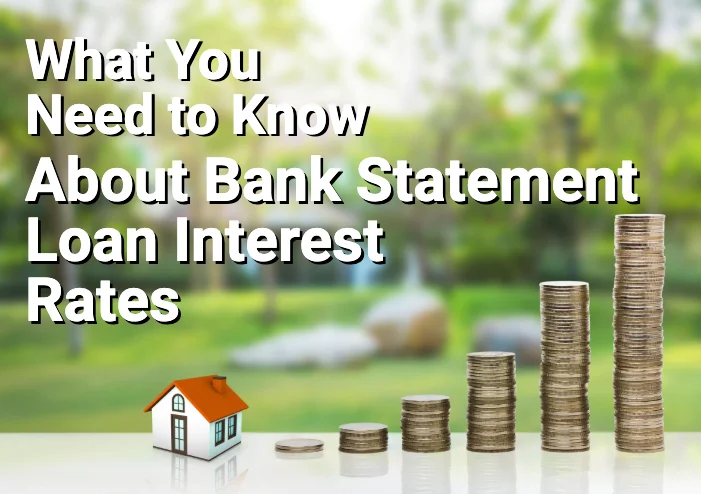The vast majority of mortgages use paystubs, as well as tax returns, to verify a potential borrower’s income. For nearly everyone, this creates a convenient way to get approved for a mortgage.
However, some borrowers need a different way to verify their incomes. Business owners and self-employed people in particular need a different path to mortgage approval, as they don’t have the typical documents used by lenders.
Instead, you can use bank statements to qualify for a mortgage. Bank statement loans simply use information from a bank account, including checking and savings, to verify a person’s regular income.
But because these loans are unique, that can come with interest rates that are different from conventional loans. If you are considering a bank statement loan, you should understand how interest rates are determined, as well as the factors that can impact the total percentage on each loan.
Bank Statement Loans Can Have Higher Rates
To a mortgage lender, it’s all about risk. Every single loan, from a small loan to a jumbo loan, has risk, so a lender will do their best to gather important information that allows them to gauge that risk. If the risk is low, they are able to offer loans with lower interest rates, but if the risk is high, they must charge a higher interest rate. With bank statement loans, the risk is often higher than normal, which means interest will be too.
So How Much Can You Expect to Pay in Bank Statement Loan Interest Rates?
Of course, everyone wants to know how much they will pay on interest for their loan. This is an important question, but for the sake of this article… it’s a question we can’t answer!
Unfortunately, interest rates change dramatically based on personal factors as well as the overall market. In order to get a clear answer on how much you will pay in overall interest, you need to talk with a qualified lending agent. It’s simply impossible to say how much you will pay, so contact a lending office you trust for a more reliable answer.
We admit, that was a complete non-answer. However, we can at least help you understand the factors that could impact your overall score. With this information, you may be able to lower the rate you pay on your bank statement loan.
How is Your Interest Rate Determined? A Brief Look at Important Factors
Status of the Bank Statements
The status of your bank accounts will impact the interest rates, as certain items in the loan could indicate higher risk to the lender. Bounced checks, for example, are a sign that a borrower may be unorganized with their finances, and may neglect to stay up on their mortgage payments. Large, undocumented deposits are also an issue, as they imply that your closing costs and downpayment could be coming from an unacceptable source. For example, if the funds were borrowed from a friend or relative, they would be ineligible for use and could increase your interest rate.
Credit Score

Bank statement loans are no different than almost every other form of lending: they require the use of a credit score to verify a borrower’s risk level and complete the transaction. Generally speaking, the higher your score the lower the rate on your bank statement loan, and you can raise your score by maintaining responsible borrowing and keeping your debt load to a minimum.
Downpayment
The size of your down payment, which directly impacts your loan-to-value ratio, will change the amount of risk assumed by the lender. Statistically speaking, borrowers who bring a higher down payment are a lower risk to lenders, so you may be rewarded with a low interest rate if you can bring a downpayment of 20% or more.
Debt-to-Income Ratio
Extremely important to lenders, your debt-to-income ratio, or “DTI,” is simply a statement of your overall monthly debt payments compared to your monthly income. Lenders want to see a low DTI, as higher ratios create a higher statistical chance of default on the loan.
Fixed or Adjustable?
There are two basic types of home loans: fixed-rate and adjustable-rate mortgages. With a fixed-rate mortgage, you pay the exact same interest rate throughout the entire life of your loan. If, for example, your 30-year loan starts with a 4.5% interest rate, three decades later you will be paying a 4.5% interest rate.
Adjustable-rate mortgages, also called “ARM loans,” have an interest rate that changes with the overall lending market. While the amount it can rise is capped, if interest rates rise the rate on your loan will increase as well, meaning you will pay more. If rates go down, however, you could save money.
While fixed-rates may start with a higher rate, they are generally considered a low-risk option, as your rate is locked for the entire life of your loan.
Loan Timeframe (Terms)
The difference in 30-year loan and a 15-year loan can impact the interest rates as well. Generally, a 15-year loan will have a lower interest rate, because the timeframe for a possible default on the loan is essentially cut in half. While many people prefer the lower monthly payments of a 30-year loan, you may want to consider a shorter option if decreasing the interest rate is a priority.
Loan Size
The loan size will also make a difference in how much you pay in interest. In many cases, a smaller loan will come with a smaller interest rate, although this is not always true.
You Deserve a Bank Statement Loan with a Low Interest Rate
Do you want to learn more about interest rates on a bank statement loan? Contact our staff for more information on getting approved for a loan that fits your unique needs.
With a passion for service and a dedication to common-sense underwriting, we are proud to be San Diego’s source for top-quality bank statement loans.


